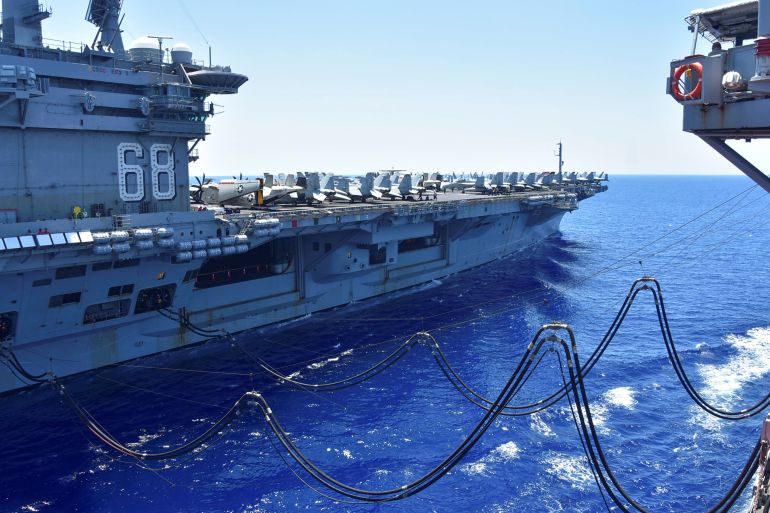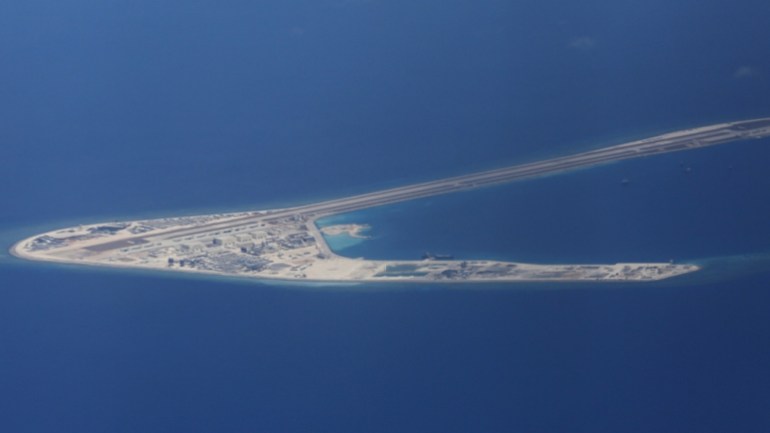Two US carrier groups conduct exercises in South China Sea
Carrier strike groups Theodore Roosevelt and Nimitz carried out multiple military manoeuvres in the busy resource-rich waterway.

Two US carrier groups launched joint exercises in the South China Sea days after a US warship sailed near Chinese-controlled islands in the disputed waters that have emerged as another flashpoint in strained Sino-US relations.
The Theodore Roosevelt Carrier Strike Group and the Nimitz Carrier Strike Group “conducted a multitude of exercises aimed at increasing interoperability between assets as well as command and control capabilities”, the US Navy said on Tuesday, marking the first dual-carrier operations in the busy waterway since July 2020.
Keep reading
list of 4 itemsUS slams China’s ‘destabilising’ South China Sea military flights
China to conduct South China Sea military exercises
US stresses South China Sea support amid China ‘pressure’
The exercise comes days after China condemned the sailing of the USS John S McCain destroyer near the Chinese-controlled Paracel Islands in what the US calls a “freedom of navigation operation” – the first such mission by the US navy since President Joe Biden took office.
The busy waterway, through which as much as $5.3 trillion in global trade passes annually, is one of a number of flashpoints in the US-China relationship.
The US has contested China’s extensive territorial claims in the region, accusing it of militarising the South China Sea and trying to intimidate neighbours such as Malaysia, the Philippines and Vietnam, who have claims that overlap with China’s in the resource-rich area.
“We are committed to ensuring the lawful use of the sea that all nations enjoy under international law,” Rear Admiral Jim Kirk, commander of the Nimitz Carrier Strike Group, said in a statement.
Beijing’s foreign ministry responded to the deployment saying it will take “necessary measures to resolutely safeguard national sovereignty and security”.
China will take necessary measures to resolutely safeguard national sovereignty and security, Chinese FM spokesperson Wang Wenbin said in response to the US’ dual carrier operations in the South China Sea on Tuesday. pic.twitter.com/GFEADjogYD
— Global Times (@globaltimesnews) February 9, 2021
The latest exercise also comes just days after a separate “mine warfare exercise” between the US Navy and Japan’s Maritime Self-Defence Force off the coast of southwestern of Japan.
Late on Friday in Washington, DC, US Secretary of State Antony Blinken had told Yang Jiechi, a senior Chinese official, that the US would hold Beijing “accountable for its efforts to threaten stability in the Indo-Pacific, including across the Taiwan Strait, and its undermining of the rules-based international system”.
Claim to the South China Sea
China has been infuriated by the US’s repeated forays in the South China Sea and has accused Washington of deliberately stoking tension.
China says it has irrefutable sovereignty over most of the South China Sea – a claim that has been declared to have “no merit” by the International Court of Arbitration at The Hague.
China refused to participate in that arbitration case, filed by the Philippines, and later dismissed the ruling as “null and void”.
China itself has also been stepping up its activities in the region, building artificial islands and constructing naval and aerial facilities amid protests from its neighbours.

In January, Beijing passed a law that for the first time explicitly allows its coastguard to fire on foreign vessels.
The Coast Guard Law empowers it to “take all necessary measures, including the use of weapons when national sovereignty, sovereign rights, and jurisdiction are being illegally infringed upon by foreign organisations or individuals at sea”.
China’s coastguard is the most powerful force of its kind in the region and is already active in the vicinity of uninhabited East China Sea islands controlled by Japan but claimed by Beijing, as well as in the South China Sea.